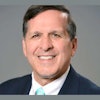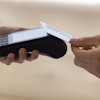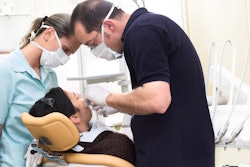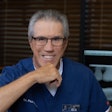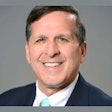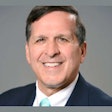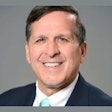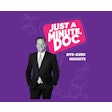The last patient is gone, the team has left, and you've addressed the most urgent notes on your desk. All is quiet except your mind, which is spinning a hundred miles an hour. What is rolling around in there?
 Sandy Baird, MBA.
Sandy Baird, MBA.
Are you fuming about the three patients who didn't show up today? Or are you frustrated with how behind schedule you ran because you had to be in three places at once all day long? Or perhaps you are reflecting on the fact that you didn't have time to go to the bathroom all day, yet you didn't collect enough to cover the day's payroll. Or maybe you are trying to understand why your front desk and clinical teams can't seem to get it together. Or you could be pondering your practice's low growth rate over the last two years.
It could be that all of these worries are wrestling each other in your mind, making you feel overwhelmed, exhausted, deflated, frustrated, and fed up. Does this sound the least bit familiar?
Compared to your dental peers
What are your headaches as a dentist, practice owner, and/or office manager? Having worked in dentistry for over 40 years, I am always interested in the answer to this question. So before the new year, I conducted a short online survey. It had five questions and 61 responses, which are summarized below.
Professional burnout
1. Rank your burnout symptoms 1-5 (1 being no symptoms and 5 being at the point of shuttering the door).
a. Level 1: 0%
b. Level 2: 31%
c. Level 3: 30%
d. Level 4: 33%
e. Level 5: 7%
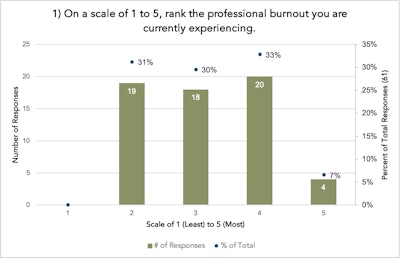
Professional burnout is one of the biggest threats to today's dental industry. The ADA discovered that more than 40% of dentists report dealing with symptoms of burnout. The key to beating burnout is to learn to prevent it before you feel the burn.
If you don't start early, you could lose your profession, retirement savings, and perhaps your mind. Don't despair, there are proven operations and systems to reduce your daily stress level and allow you more time away from work stress. Please don't ignore the importance of this threat or the fact that you must start early to prevent it.
New dental patient appointments
2. How soon can you schedule your next new patient appointment?
a. 1-14 days: 10%
b. 15-30 days: 64%
c. 31-40 days: 20%
d. >40 days: 3%
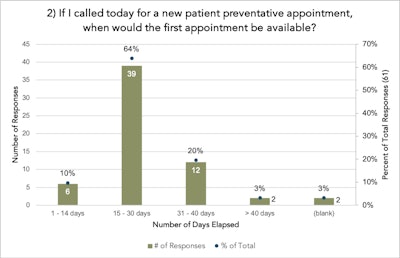
Every dentist knows that new patients are the lifeblood of a thriving and healthy practice. Without them, your practice will wither, stagnate, and eventually cease producing an adequate income. According to the ADA, the average wait time for a new patient appointment is 15 days.
This means if you schedule a new patient appointment for more than two weeks out, the prospective patient probably will not show up. Why? Because they called another dental practice and received an earlier appointment. Oh and by the way, they probably won't let you know they are not coming, so get ready for empty chair time. To ensure new patients can be scheduled within an acceptable time, implement an effective preblocking scheduling system in your practice.
Dental team development
3. When was your last team development day?
a. Within the last two months: 18%
b. Within the past six months: 59%
c. More than six months ago: 22%
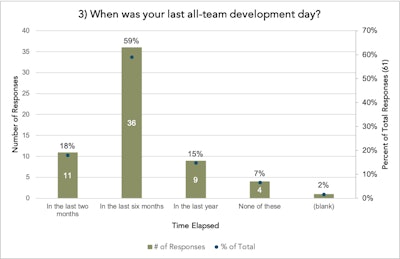
When it comes to team events, we need to define some terms. A team development day or retreat is different from a team-building event:
- A team development event involves improving team communications, efficiencies, customer service, operating systems, and skills in the dental practice.
- A team-building day is an offsite activity to help bond the team members socially. Examples of team-building events include bowling, rafting, and community service activities.
Both team development and team-building events are critical for creating a high-functioning team that is engaged, productive, and stays. According to Gallup, U.S. employee engagement is at a 10-year low, with only 31% of employees feeling engaged at work. The other 69% are at high risk of resigning, missing work, and providing poor customer service and low production while creating office drama. Engaging your employees in both types of team development events twice a year will greatly reduce turnover, absenteeism, and disengagement while increasing productivity and team synergy
Net new dental patient average
4. What is your average new patient number in the last six months?
a. < 30: 25%
b. 31-40: 41%
c. > 40: 30%
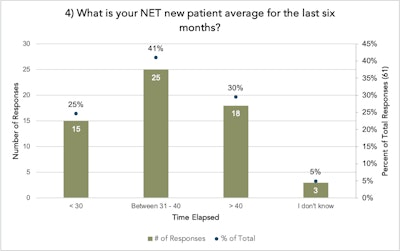
These figures are not your true new patient count. To calculate your true or net new patient flow, you must subtract from your total new patient count the number of patients who rolled over into inactive status.
Inactive status describes patients you haven't seen in 18 months. Then you must subtract the number of current patients who came in after three years and qualified for another comprehensive examination. They are not new patients but reactivated patients. Many dentists find after doing these calculations that their new patient count is less than 30 or even a negative number, which means their practice is shrinking and withering.
Most pressing concerns in the dental practice
5. What are your most pressing concerns for your practice?
a. Scheduling: 31%
b. Communications: 26%
c. Practice growth: 23%
d. Team development and retention: 18%
e. Other: 2%
- Dealing with insurance
- Managing employees
- Hiring clinical personnel
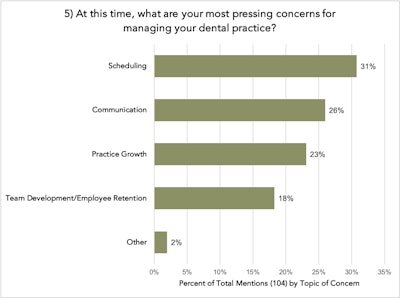
Where are your top practice concerns on this spectrum? Perhaps your biggest headache is not even listed. It might be overhead, competition, team drama, or something else. If you haven't already participated in the survey, please do so by clicking this link to provide your feedback. With additional input, more solutions will be found, which will help everyone.
The important thing to know is there are proven operating systems, processes, and solutions to improve all these issues. Resolving your headaches now is a huge step in reducing your stress level and the chance of future professional burnout. You have worked too hard and invested too much in your career to allow yourself to ignore these concerns and keep walking straight toward that career-ending cliff of professional burnout. Take action to stop the burn now. Contact Baird Dental Business Concepts for a complimentary consultation.
References
- Harter J. "U.S. Employee Engagement Sinks to 10-Year Low." Gallup.com. Published January 14, 2025. https://www.gallup.com/workplace/654911/employee-engagement-sinks-year-low.aspx.
- Gallup. "How to Improve Employee Engagement in the Workplace." Gallup. Published 2022. https://www.gallup.com/workplace/285674/improve-employee-engagement-workplace.aspx.
- Feeling burned out? You’re not alone. ADA.org. Published 2019. https://adanews.ada.org/ada-news/2024/april/feeling-burned-out-you-re-not-alone/
Sandy Baird, MBA, has more than 40 years of hands-on dental management experience, offering general dentists a wide selection of management services, including team, business, financial, or operational management. She can be contacted at Baird Dental Business Concepts.
The comments and observations expressed herein do not necessarily reflect the opinions of DrBicuspid.com, nor should they be construed as an endorsement or admonishment of any particular idea, vendor, or organization.


